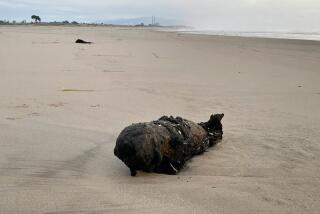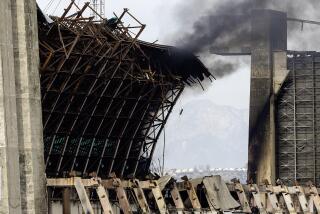Public Forum Considers Uses for Tustin Base
- Share via
TUSTIN — When the Pentagon decided two years ago to close the Tustin Marine Corps Air Station, Bob Sterling worried about future development in the area.
Sterling, a 20-year resident here, wanted to make certain that plans would not bring congestion, pollution or other problems to this and surrounding cities.
On Saturday, Sterling, community leaders and other residents got a chance to air their views about the future of the 1,600-acre Tustin helicopter base, which officially closes July 10 as part of the Pentagon’s effort to reduce the size of the U.S. armed services.
“I’m very concerned that we do not make the mistake of putting commercial development over the needs of the people,” Sterling said. “I would like to see recreational facilities developed.”
Like Sterling, about 45 others voiced concerns and suggestions at the MCAS Tustin Re-use Plan Community Workshop, the first of three public workshops on the issue.
“I wish more residents had come,” said Jeanette Dinwiddie-Moore), who will soon move to Tustin. “It’s a fantastic opportunity to plan for your community.”
Working in small groups, participants developed ideas for the site, ranging from educational to recreational uses. Some wanted to create an aviation or aerospace museum around one of the two blimp hangars on base. Others suggested making military housing units available to low-income residents or senior citizens.
Many wanted to incorporate the distinguished history of the base into future plans. The blimp hangars at the base are considered the largest unsupported wooden structures in the world and are designated national landmarks.
Future uses will depend on several factors, including the possible closure of the El Toro Marine Corps Air Station.
If that base closes, approximately 400 acres of the Tustin base previously reserved to house El Toro officers will also be available for possible development, said Col. Leonard Fuchs, community plans and liaison officer at El Toro.
Col. Tom Braaten, commanding officer of the Tustin base, said the Marine Corps and the community “have been working really close from the start.”
Shortly after the closure was announced in July, 1991, the city formed a task force that included elected officials and Marine Corps representatives to develop new uses for the base.
Braaten and other task force members have hailed joint efforts between the Pentagon and the community as unique to base conversions.
It is also one of the first times the Pentagon and a city are conducting joint state- and federal-mandated environmental studies, one of several cooperative efforts between the two parties, Braaten said.
In the next several months, the task force will sift through community surveys and opinions to present three alternative plans. The city will adopt one of those plans in May, 1994, to recommend to the Pentagon.
While the secretary of the Navy makes the final decision on the sale and redevelopment of the site, workshops such as this one will enable the task force to recommend a plan favorable to community members, said William A. Huston, Tustin’s city manager.
“We think (the government) is very sincere when it says, ‘We want to do what the community wants,’ ” Huston said. The next workshop is set for September, 1994.
The base opened in 1942 as a ground facility for blimps. It was decommissioned in 1949, reopened during the Korean War, and later housed helicopters.
The Pentagon decided to close the base when military officials concluded that increasing development around the base had compromised Tustin’s military mission, and that increasing land values in Orange County would make the base a prime property for redevelopment.
More to Read
Sign up for Essential California
The most important California stories and recommendations in your inbox every morning.
You may occasionally receive promotional content from the Los Angeles Times.













